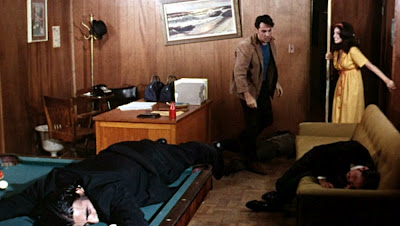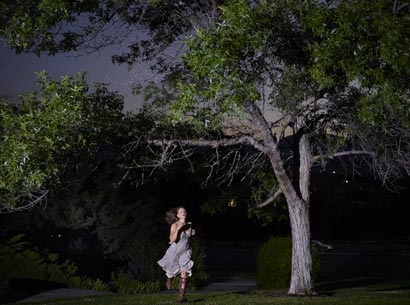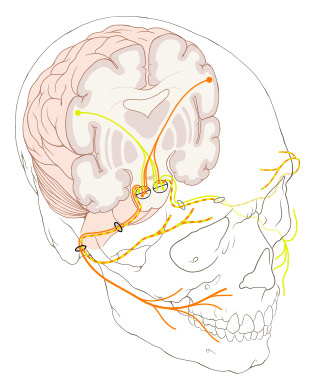science

Waking up from surgery can be disorienting. One minute you’re in an operating room counting backwards from 10, the next you’re in the recovery ward sans appendix, tonsils, or wisdom teeth. And unlike getting up from a good night’s sleep, where you know that you’ve been out for hours, waking from anesthesia feels like hardly any time has passed. Now, thanks to the humble honeybee, scientists are starting to understand this sense of time loss. New research shows that general anesthetics disrupt the social insect’s circadian rhythm, or internal clock, delaying the onset of timed behaviors such as foraging and mucking up their sense of direction. (…)
Warman says his team is currently looking at whether shining bright light at someone under anesthesia—a well known way to alter the circadian clock—could also reduce the procedure’s disorienting effects.
{ Science | Continue reading }
photo { Steve Shapiro, Truman Capote, Kansas, 1967 }
science, sleep, time | April 17th, 2012 10:27 am

In psychology, this phenomenon is called “gaslighting,” a term that has its origins in a 1938 play (and a 1940 film) called Gas Light, where a man leads his wife to believe that she is insane in order to steal from her. (…)
A classic example of psychological gaslighting is the following: Spouse A has an extramarital affair and tries to cover it up. Spouse B finds a suspicious text message in A’s phone and expresses concern to A. A then accuses B of being paranoid, and this pattern repeats every time B raises concerns. Eventually B begins to question his or her own perceptions.
{ Psych Your Mind | Continue reading }
image { Steven Pippin }
Linguistics, psychology, relationships | April 16th, 2012 4:02 pm

It’s famously tough getting through the Google interview process. But now we can reveal just how strenuous are the mental acrobatics demanded from prospective employees. Job-seekers can expect to face open-ended riddles, seemingly impossible mathematical challenges and mind-boggling estimation puzzles. (…)
1. You are shrunk to the height of a 2p coin and thrown into a blender. Your mass is reduced so that your density is the same as usual. The blades start moving in 60 seconds. What do you do? (…)
3. Design an evacuation plan for San Francisco. (…)
5. Imagine a country where all the parents want to have a boy. Every family keeps having children until they have a boy; then they stop. What is the proportion of boys to girls in this country? (…)
6. Use a programming language to describe a chicken. (…)
7. What is the most beautiful equation you have ever seen? (…) Most would agree this is a lame answer:
E = MC2
It’s like a politician saying his favorite movie is Titanic.
You want Einstein? A better reply is:
G = 8πT (…)
8. You want to make sure that Bob has your phone number. You can’t ask him directly. Instead you have to write a message to him on a card and hand it to Eve, who will act as a go-between. Eve will give the card to Bob and he will hand his message to Eve, who will hand it to you. You don’t want Eve to learn your phone number. What do you ask Bob? (…)
11. How much would you charge to wash all the windows in Seattle? (…)
14. Can you swim faster through water or syrup?
{ Wired | Continue reading }
images, clockwise from top left { 1 | 2 | 3 | 4 | 5 | 6 }
quote { thanks Tim }
economics, google, guide, ideas, mathematics | April 16th, 2012 5:57 am

Psychology research shows most people wrongly assume their thoughts can become reality — even people who say they don’t believe in telekinesis or ESP. “If you think about something and then it happens, you feel a little bit responsible for it,” Hutson said. It’s an irrational feeling. Why do we feel it?
“It’s a byproduct of how we understand causality,” he said. “If there are two events, A and B, if A happens before B, if there are no other obvious causes of B, and if A and B are conceptually related, then we assume A caused B.”
The faulty logic gets reinforced every time you think a positive thought, such as visualizing a successful basketball free throw, and then the thought boosts your confidence, which affects your behavior, and — voila! — the ball swooshes through the net. (…)
Few Americans openly practice voodoo — e.g., inserting pins into figurines of their enemies in order to inflict bad luck or pain — but studies show we’re all secret practitioners. “When you do some symbolic action or perform some symbolic ritual, you tend to think it will bring about what it symbolizes,” Hutson said.
In a recent experiment, psychologists monitored people’s perspiration levels as they cut up a photograph of a cherished childhood possession. Unsurprisingly, destroying a representation of their childhood made the participants sweat.
{ LiveScience | Continue reading }
photo { Danielle Levitt }
photogs, psychology | April 16th, 2012 5:54 am

When the sun goes down in the subtropical forests of Puerto Rico, hundreds of thousands of bats emerge from the caves that stud the island’s northern end. After a day of sleeping, the animals are ready for a hard day’s night of hunting insects. For some of them, though, there will be no feast of beetles and mosquitos, and they’ll instead wind up a meal themselves for the snakes that have set up an ambush at the cave’s entrance. (…)
The nightly ritual is played out on its largest scale at La Cueva de Los Culebrones, or the Cave of the Long Snakes. The cave’s estimated 300,000 bats can empty out in as little as three hours, providing the boas with an all-you-can-eat bat buffet. Biologists observers have seen as many as 20 boas hanging around the cave entrance. (…)
Sometimes, a snake that’s not having any luck with its own hunting will attempt to steal a bat from another snake. On one occasion, a biologist watched three snakes fight over a large bat carcass for over an hour and a half.
{ Matt Soniak | Continue reading | video }
animals, science | April 16th, 2012 5:51 am

From the mouth and nose, through the pharynx into the trachea, separating into the left and right main bronchi at the larynx. This is the start of your airway. This is to be the site of inflammation, or rather, the site of battle. Across the landscape that is the airways, two sides are about to go to war. Invading pathogens versus human inflammatory cells, in a war that will eventually lead to pneumonia.
{ science left untitled | Continue reading }
health, science | April 16th, 2012 5:49 am

Tessa Price, a 22-year-old college senior, is gazing into a mirror in a virtual-reality laboratory at Stanford University. Looking back at her is Tessa Price—at the age of 68.
Staring into a mirror today and seeing yourself as you will look in the year 2057 is unnerving. But that may be just what it takes to shock Americans into saving more. At Stanford and other universities, computer scientists, economists, neuroscientists and psychologists are teaming up to find innovative ways of turning impulsive spenders into patient savers. (…)
It isn’t surprising that the young typically don’t want to save for their retirement, since that stage of life feels as if it will be lived by someone else. (…)
These researchers are tapping into what is called the Proteus effect, behavioral alterations in the real world that are triggered by changes in how our bodies appear to us in a virtual world.
{ WSJ | Continue reading }
economics, future, psychology | April 13th, 2012 12:00 pm

Homophobia is more pronounced in individuals with an unacknowledged attraction to the same sex and who grew up with authoritarian parents who forbade such desires, a series of psychology studies demonstrates. The research is the first to document the role that both parenting and sexual orientation play in the formation of intense and visceral fear of homosexuals. (…)
“In many cases these are people who are at war with themselves and they are turning this internal conflict outward,” adds co-author Richard Ryan, professor of psychology at the University of Rochester who helped direct the research.
{ University of Rochester | Continue reading }
photo { Jessica Eaton }
photogs, psychology, relationships, visual design | April 13th, 2012 11:59 am

Reliable and unbiased random numbers are needed for a range of applications spanning from numerical modeling to cryptographic communications. While there are algorithms that can generate pseudo random numbers, they can never be perfectly random nor indeterministic.
Researchers at the ANU are generating true random numbers from a physical quantum source. We do this by splitting a beam of light into two beams and then measuring the power in each beam. Because light is quantised, the light intensity in each beam fluctuates about the mean. Those fluctuations, due ultimately to the quantum vacuum, can be converted into a source of random numbers. Every number is randomly generated in real time and cannot be predicted beforehand.
{ Australian National University | Continue reading }
photo { Hiroshi Sugimoto, Orange Drive-in, 1993 }
mathematics, technology | April 13th, 2012 9:59 am

Baboons have mastered one of the basic elements of reading - identifying the difference between sequences of letters that make up actual words from nonsense sequences.
Although the animals have no linguistic skills, they were able to classify a four-letter sequence as either a real word or a random sequence. These findings challenge the long-held notion that the ability to recognise words in this way - as combinations of objects that appear visually in certain sequences - is fundamentally related to language.
It now appears that when humans read, we are partly drawing on an ancient ability, predating the evolution of our own species.
Linguists agree that language is needed during reading, but at which stage language becomes a necessity has come under debate. Past research has shown that animals have the ability to discriminate letters from one another, but previously experts thought the ability to recognise words was dependent on an ability to understand language.
{ Cosmos | Continue reading }
photo { Robin Schwartz }
Linguistics, animals, science | April 13th, 2012 8:08 am

A few blocks later, Zupan wants to demonstrate what he calls “shy distance”: how close you get to an approaching person with whom you are bound to collide before one of you shifts to the side. The process is sometimes anticipated with a kind of foreplay, what Nicholson Baker in The Mezzanine described as “the mutual bobbings you exchange with an oncoming pedestrian, as both of you lurch to indicate whether you are going to pass to the right or to the left.” Scanning the sidewalks, Zupan announces, “I’m going to find someone who’s not looking at their phone. I usually try to find someone smaller than me.” He finds his mark: an ordinary commuter in Dockers and oxford shift, striding purposefully. Zupan puts his head down, and gets to within a few feet before the man breaks right, shooting back an irritated glare. (As Zupan wrote in Urban Space, “Pedestrians have been found to take evasive action anywhere from 2 to 17 ft ahead of a stationary or moving obstacle.”)
What might be for some the unchoreographed whir of the city is for Zupan a set of discrete patterns; if a pattern can’t be observed, it probably just means you haven’t looked long enough. Block by block, they emerge: The way people drift toward the shady side of the street on hot days; the way women (in particular) avoid subway grating on the sidewalk; the way walking speeds are slower at midday than before or after work; the way people don’t like to maintain the same walking speed as a stranger next to them. (…)
When do people choose to take the escalator versus the stairs? How crowded does the former have to be before the latter is chosen?
{ Slate | Continue reading }
photo { Paul McDonough, NY City, 1973-1978 }
photogs, psychology | April 13th, 2012 5:48 am

According to what some call the strong definition of free will, articulated by René Descartes in the 17th century, you are free if, under identical circumstances, you could have acted otherwise. Identical circumstances refer to not only the same external conditions but also the same brain states. (…)
Contrast this strong notion of freedom with a more pragmatic conception called compatibilism, the dominant view in biological, psychological, legal and medical circles. You are free if you can follow your own desires and preferences. A long-term smoker who wants to quit but who lights up again and again is not free. His desire is thwarted by his addiction. Under this definition, few of us are completely free. (…)
Consider an experiment that ends with a 90 percent chance of an electron being here and a 10 percent chance of it being over there. If the experiment were repeated 1,000 times, on about 900 trials, give or take a few, the electron would be here; otherwise, it would be over there. Yet this statistical outcome does not ordain where the electron will be on the next trial. Albert Einstein could never reconcile himself to this random aspect of nature. (…)
This experiment was conceived and carried out in the early 1980s by Benjamin Libet, a neuropsychologist at the University of California, San Francisco. (…)
Intuitively, the sequence of events that leads to a voluntary act must be as follows: You decide to raise your hand; your brain communicates that intention to the neurons responsible for planning and executing hand movements; and those neurons relay the appropriate commands to the motor neurons that contract the arm muscles. But Libet was not convinced. Wasn’t it more likely that the mind and the brain acted simultaneously or even that the brain acted before the mind did?
Libet set out to determine the timing of a mental event, a person’s deliberate decision, and to compare that with the timing of a physical event, the onset of the readiness potential after that decision. (…)
The results told an unambiguous story, which was bolstered by later experiments. The beginning of the readiness potential precedes the conscious decision to move by at least half a second and often by much longer. The brain acts before the mind decides! This discovery was a complete reversal of the deeply held intuition of mental causation.
{ Scientific American | Continue reading }
photo { Tabitha Soren }
ideas, neurosciences, photogs | April 13th, 2012 5:00 am

Scientists are increasingly finding that depression and other psychological disorders can be as much diseases of the body as of the mind. (…)
Scientists are finding that the same changes to chromosomes that happen as people age can also be found in people experiencing major stress and depression.
The phenomenon, known as “accelerated aging,” is beginning to reshape the field’s understanding of stress and depression not merely as psychological conditions but as body-wide illnesses in which mood may be just the most obvious symptom.
{ WSJ | Continue reading }
genes, psychology, science | April 13th, 2012 5:00 am

The discovery [of the Higgs boson], if confirmed, will mark the culmination of a hunt that has taken years and cost billions of dollars, and will shape the field for years to come. (…) What fundamental discoveries in biology might inspire the same thrill? We put the question to experts in various fields. (…)
Is there life elsewhere? (…)
Is there foreign life on earth? (…) Some have postulated the existence of a ’shadow biosphere’ on Earth, teeming with life that has gone undiscovered because scientists simply don’t know where to look. It could contain life that relies on a fundamentally different biochemistry, using different forms of amino acids or even entirely novel ways of storing, replicating and executing inherited information that do not rely on DNA or proteins. (…)
How did life start…? (…) Joyce says that there will come a point at which researchers learn how to synthesize an evolving, replicating system from scratch. (…) Several labs have already made headway. (…) In 2009, a paper from Joyce’s lab reported the development of a system of RNA molecules that undergo self-sustaining Darwinian evolution5. But enzymes and a human hand were needed to create the RNA sequences to start off the reaction, Joyce says, and so far his lab has not found conditions that would allow the system to form spontaneously. “We’re still a bit challenged,” he says. “But the system is running more and more efficiently all the time.” (…)
… and can we delay its end? (…) Cynthia Kenyon and her colleagues at the University of California, San Francisco, reported that mutations in a single gene allowed the nematode Caenorhabditis elegans to live more than twice as long as usual. Three years later, a group led by Andrzej Bartke, who studies ageing at Southern Illinois University in Springfield, reported that mice bearing a single mutation that causes hormonal deficiencies live up to 68% longer than mice without the mutation. Both papers, and a slew of work since, have suggested that it might be possible to significantly slow human ageing and its associated diseases.
{ Nature | Continue reading }
image { Trevor Brown }
mystery and paranormal, science | April 12th, 2012 10:21 am

Among the most surprising discoveries about memory has been the realisation that remembering a past event is not like picking a DVD off the shelf and playing it back. Remembering involves a process of reconstruction. We store assorted features of an event as representations that are distributed around the brain.
In simple terms, visual features are represented near the back of the brain in the areas specialised for visual processing; sounds in auditory processing regions close to the ears; and smells in the olfactory system that lies behind the nose.
To experience the rich, vivid “re-living” of a past event that is remembering, we fit these features together into a representation of what took place.
A lot of stuff happens in our lifetimes, and so it makes sense that our brains would have evolved some efficient memory strategies. We don’t try to remember every single event in its entirety. Instead, we store the elements of an event, and put them together in different ways to make different memories. The downside is that similar events that share a number of features may be more difficult to remember.
Our experiment was designed to investigate this effect.
{ Guardian | Continue reading }
artwork { Sougwen Chung | Thanks Tim }
memory | April 12th, 2012 10:12 am

New scientific research raises the possibility that advanced versions of T. rex and other dinosaurs — monstrous creatures with the intelligence and cunning of humans — may be the life forms that evolved on other planets in the universe. “We would be better off not meeting them,” concludes the study, which appears in the Journal of the American Chemical Society. (…)
“An implication from this work is that elsewhere in the universe there could be life forms based on D-amino acids and L-sugars. Such life forms could well be advanced versions of dinosaurs, if mammals did not have the good fortune to have the dinosaurs wiped out by an asteroidal collision, as on Earth.”
{ ACS | Continue reading }
science, theory | April 12th, 2012 7:44 am

Natural selection never favors excess; if a lower-cost solution is present, it is selected for. Intelligence is a hugely costly trait. The human brain is responsible for 25 per cent of total glucose use, 20 per cent of oxygen use and 15 per cent of our total cardiac output, although making up only 2 per cent of our total body weight. Explaining the evolution of such a costly trait has been a long-standing goal in evolutionary biology, leading to a rich array of explanatory hypotheses, ranging from evasion of predators to intelligence acting as an adaptation for the evolution of culture. Among the proposed explanations, arguably the most influential has been the “social intelligence hypothesis,” which posits that it is the varied demands of social interactions that have led to advanced intelligence.
{ Proceedings of The Royal Society B | Continue reading }
brain, ideas, science | April 11th, 2012 11:36 am

Anyone who has committed a crime should hope that the jury that tries him is happy. According to Forgas, his experiments show that cheerful people are easier to deceive, couldn’t detect lies as easily as those in negative moods and couldn’t tell a thief from an honest person. (…)
And there are more flip sides of happiness: Feeling good makes people more selfish (if asked to divide raffle tickets between themselves and others, they’ll keep more in their pockets than sad people) and worse at defending their opinions (they produce weaker, less detailed arguments). The happiest of us are also less creative than those who describe themselves as just “happy enough.”
Even just striving to feel cheerful might make us less happy.
{ Washington Post | Continue reading }
psychology | April 11th, 2012 11:25 am

Scientists report that they have mapped the physical architecture of intelligence in the brain. Theirs is one of the largest and most comprehensive analyses so far of the brain structures vital to general intelligence and to specific aspects of intellectual functioning, such as verbal comprehension and working memory. (…)
“We found that general intelligence depends on a remarkably circumscribed neural system,” Barbey said. “Several brain regions, and the connections between them, were most important for general intelligence.”
These structures are located primarily within the left prefrontal cortex (behind the forehead), left temporal cortex (behind the ear) and left parietal cortex (at the top rear of the head) and in “white matter association tracts” that connect them.
The researchers also found that brain regions for planning, self-control and other aspects of executive function overlap to a significant extent with regions vital to general intelligence.
The study provides new evidence that intelligence relies not on one brain region or even the brain as a whole, Barbey said, but involves specific brain areas working together in a coordinated fashion.
{ University of Illinois | Continue reading }
brain, neurosciences | April 10th, 2012 2:02 pm






















